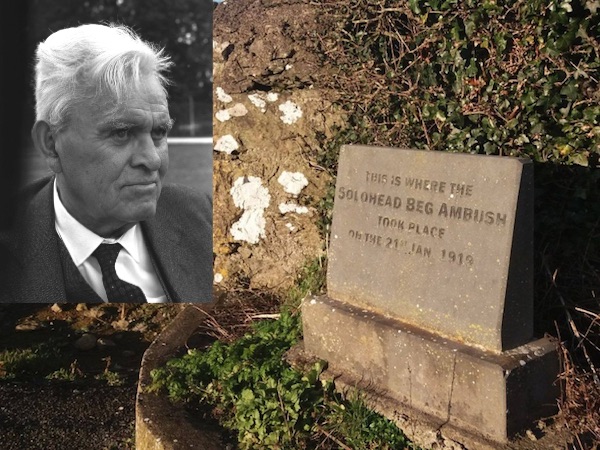
By Dirk de Klein (dirkdeklein.net)
One hundred years this week, on a quiet Tipperary roadway, the first nationalist revolt against the British Empire last century was started by a small band of armed men from townlands and villages -- Donohill, Solohead and Hollyford -- in the vicinity of Tipperary Town. The Soloheadbeg ambush shook British rule in Ireland.
On the same day, the First Dail was meeting, an ambush took place at Soloheadbeg, County Tipperary, that is now seen as being the opening skirmish in the War of Independence.
An unauthorised attack led by Sean Treacy and Dan Breen but also involving Sean Hogan, Seamus Robinson, Tadhg Crowe, Patrick McCormack, Patrick O’Dwyer, Michael Ryan and Sean O’Meara (the latter two being cycle scouts), resulted in the deaths of two RIC constables, James McDonnell and Patrick O’Connell.
Although much of nationalist Ireland went on to support the war against Britain, this attack evoked outrage at the time. Breen (pictured, inset), a ruthless, brilliant guerilla fighter later said ‘The people had voted for a Republic; now they seemed to abandon us who tried to bring that Republic nearer, for we had taken them at their word. Our former friends shunned us. They preferred the drawing-room as a battleground.’
Constables James McDonnell and Patrick O’Connell (both Irish born Catholics), had been walking with loaded rifles escorting a horse drawn cart containing a load of gelignite from Tipperary Military Barracks for blasting purpose at Soloheadbeg Quarry (located 3 miles from Tipperary).
Each day from 16 to 21 January, the men chosen for the ambush took up their positions from early in the morning to late afternoon and then spent the night at the ‘Tin Hut’.
On 21 January, around noon, Patrick O’Dwyer saw the transport leaving the barracks. The consignment was on a horse-drawn cart, led by two council men and guarded by two RIC officers armed with rifles.
O’Dwyer cycled quickly to where the ambush party was waiting and informed them. Robinson and O’Dwyer hid about 30 metres in front of the main ambush party of six, in case they rushed through the main ambush position.
After the transport reached the position where the main ambush party was hiding, masked volunteers appeared in front of them with their guns drawn and called on them to surrender. The two officers took up firing positions and the volunteers immediately fired upon them. Both RIC officers, James McDonnell and Patrick O’Connell, were killed.
As planned, Hogan, Breen and Treacy took the horse and cart with the explosives and sped off. They hid the explosives in a field in Greenane and threw a few sticks out on the roadside a few miles further on as a decoy. The explosives were moved several times and later divided up between the battalions of the brigade.
Tadhg Crowe and Patrick O’Dwyer took the guns and ammunition from the dead officers, while Robinson, McCormack and Ryan guarded the two council workers, James Godfrey and Patrick Flynn, before releasing them once the gelignite was far enough away.
Breen gave apparently conflicting accounts of their intentions that day. One account implies that the purpose of the confrontation was merely to capture explosives and detonators being escorted to a nearby quarry. The other was that the group intended killing the police escort to provoke a military response.
“Treacy had stated to me that the only way of starting a war was to kill someone, and we wanted to start a war, so we intended to kill some of the police whom we looked upon as the foremost and most important branch of the enemy forces.... The only regret that we had following the ambush was that there were only two policemen in it, instead of the six we had expected.”
The ambush would later be seen as the beginning of the Irish War of Independence, and it is claimed the men acted on their own initiative to try to start a war.
The British government declared South Tipperary a Special Military Area under the Defence of the Realm Act two days later.
A meeting of the Executive of the Irish Volunteers took place shortly thereafter. On 31 January, An t-Oglach (the official publication of the Irish Volunteers) stated that the formation of Dail Eireann “justifies Irish Volunteers in treating the armed forces of the enemy - whether soldiers or policemen - exactly as a National Army would treat the members of an invading army”.
![[Irish Republican News]](https://republican-news.org/graphics/title_gifs/rn.gif)
![[Irish Republican News]](https://republican-news.org/graphics/title_gifs/harp.gif)

